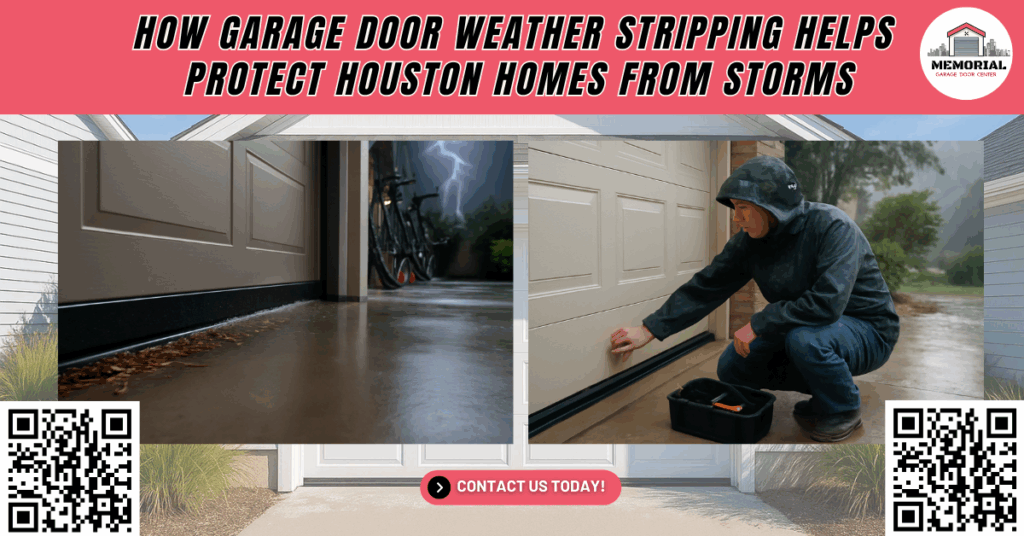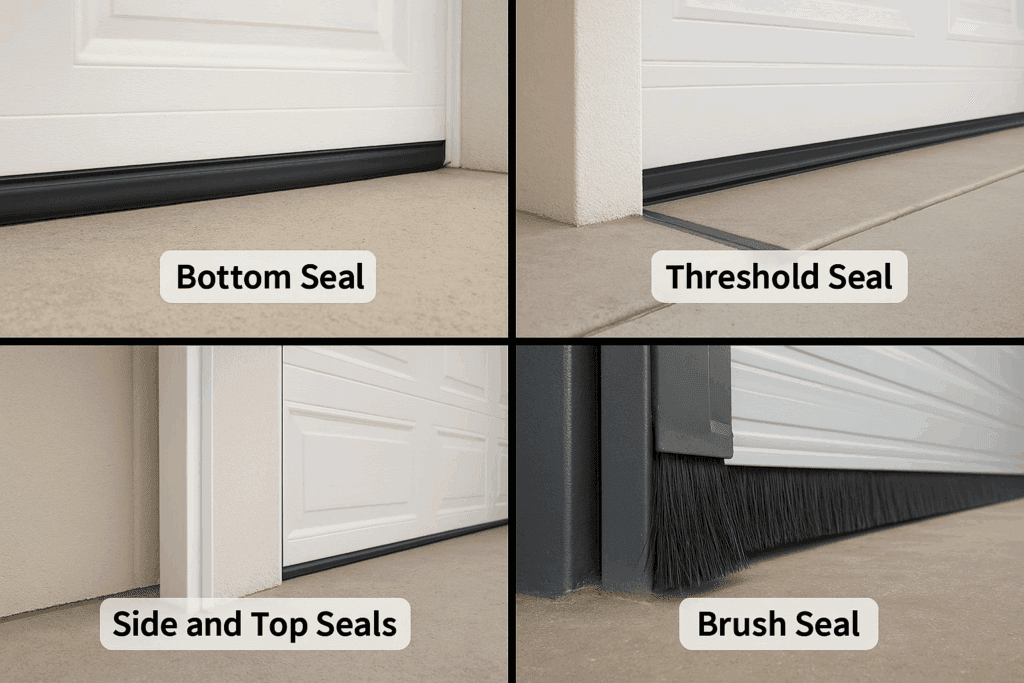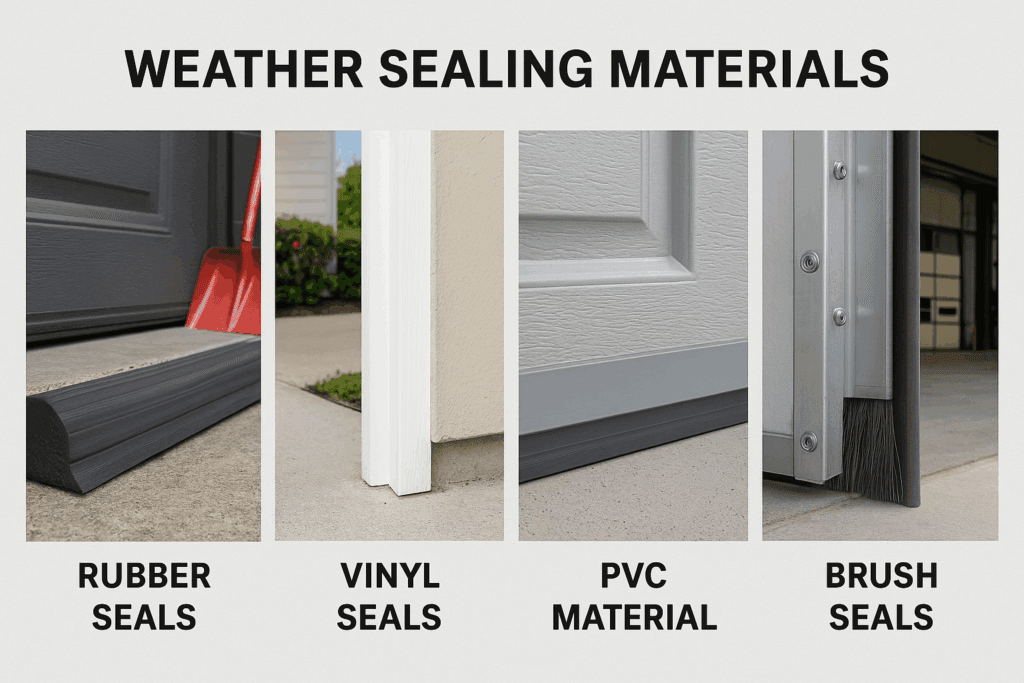
A few seasons ago, a family residing in Houston’s Heights neighborhood experienced significant garage flooding during a relentless thunderstorm. The culprit was immediately clear during our inspection. Their garage door had no weatherstripping at all. Water surged under the door and damaged their stored belongings, leaving behind stains, a persistent musty odor, and even mold growth on drywall and baseboards. After installing new garage door weather stripping, including a premium rubber bottom seal and heavy-duty threshold seal, their garage remained completely dry in future storms, even when winds reached over 80 km/h during Hurricane Nicholas.
In Houston, which receives an average of over 50 inches of rainfall each year, heavy rain, wind gusts, and sudden changes in temperature are frequent challenges for homeowners. A garage door is one of the largest moving components of any home, and without a tight seal, it becomes a major entry point for water, air drafts, pests, and humidity. This is why the installation of effective garage door weather stripping is not only a wise investment but a necessary defense against costly damage, energy loss, and weather-related headaches.
Whether you live in Montrose, Memorial, or West University, properly sealing your garage doors will protect your home from storms and ensure long-term comfort, safety, and energy efficiency. Let’s explore how garage door weather stripping works, why it matters in a climate like Houston’s, and what steps you can take today to fortify your home.
What Is Garage Door Weather Stripping?
Garage door weather stripping is a barrier made from flexible materials such as rubber, vinyl, or PVC that is designed to fill gaps around the garage door. These seals are installed along the bottom, sides, and top of the garage door to create a tight, weatherproof barrier that keeps out water, wind, air drafts, dust, and pests.
The primary components include:
- Bottom Seal: This flexible rubber strip runs along the bottom edge of the garage door and compresses against the floor when the door is closed. It blocks water, dust, and cold air from entering. A quality bottom seal can also absorb minor shifts in garage floor levels and help maintain an airtight closure.
- Threshold Seal: Installed directly on the garage floor, this seal complements the bottom seal by creating an elevated barrier that stops water from seeping in, even during heavy storms. It is especially useful for homes in low-lying areas or with sloped driveways.
- Top and Side Seals: These vinyl or rubber strips are mounted along the top and vertical sides of the door frame. They prevent air drafts, debris, and moisture from sneaking in around the edges. Top seals are particularly important in areas prone to strong winds.
- Brush Seals: Often used in commercial applications, brush seal kits feature bristle-like fibers that flex to fill in gaps and are particularly effective in areas with high winds and uneven surfaces. They are also effective in garages with irregular frames or doors.

Together, these weatherstripping elements act as a comprehensive shield for your garage, enhancing your home’s overall insulation and protection from external conditions.
Why Houston Homes Are Especially Vulnerable
Houston’s climate poses unique challenges to the structural integrity and comfort of residential homes. With frequent thunderstorms, high humidity levels, and tropical storms bringing winds up to 100 km/h, garage doors in this region require special attention.
Many homeowners are surprised to learn that even small gaps in the garage door, often less than a quarter of an inch, can allow several gallons of water to infiltrate during a heavy rain event. This not only damages flooring and drywall but can also lead to expensive repairs from mold and corrosion.
In areas like Braeswood and Rice Military, where many homes have low-slope driveways or sit near bayous, water intrusion through garage doors is a constant concern. Even newly constructed homes are not immune, especially if builders do not prioritize advanced weatherproofing techniques.
Aside from water issues, the constant exposure to extreme temperatures in Houston, ranging from scorching summers with realfeel®28° realfeel shade™26° to sudden cold snaps, puts stress on all parts of the home. Without weather stripping, garage doors become weak points for energy loss, increased energy bills, and potential structural damage over time.
Key Benefits of Installing Garage Door Weather Stripping
1. Prevents Water Damage
Houston storms are known for producing several inches of rainfall in a short period of time. Without a proper seal, water can easily seep into your garage. Installing a threshold seal and a high-quality rubber bottom seal creates a physical barrier that diverts water away from your home.
This can prevent warping of wooden structures, water stains on concrete, corrosion on metal tools and storage racks, and even prevent mildew and mold growth. For homeowners storing sensitive equipment or electronics in the garage, the added protection is invaluable.
2. Blocks Air Drafts and Improves Energy Efficiency
Garage door weather stripping is critical for maintaining indoor temperatures. Gaps around the door allow hot, humid air to enter in the summer and cold air during rare winter freezes. This increases your HVAC system’s workload and leads to higher energy bills. A proper seal keeps conditioned air inside and helps lower energy costs year-round.
Proper insulation through weatherstripping can make a significant difference in attached garages where shared walls can influence the temperature of adjoining rooms. Homeowners often notice a noticeable drop in energy bills and better temperature control after sealing their garage.
3. Keeps Pests and Insects Out
Houston’s warm, humid climate is ideal for pests such as roaches, ants, spiders, and even snakes. These unwanted guests often enter through gaps under or beside the garage door. Sealing these entry points with brush seals and bottom weather stripping helps block access.
Preventing pest intrusion also means reducing the need for chemical repellents or extermination services. It is a more sustainable, preventive measure that supports both health and home maintenance.
4. Reduces Dust, Moisture, and Mold Risk
Dust and moisture can settle in the garage and create the perfect environment for mold and mildew. A tight seal around the garage door reduces these contaminants and promotes a cleaner, healthier space.
This is especially important for homeowners who use their garage as a workshop, home gym, or secondary living space. Reducing dust and moisture creates a more pleasant and safer environment for daily use.
5. Protects Valuable Items and Increases Home Value
Many homeowners use their garages to store important items. Sealing the space ensures those items remain safe from water, rust, and climate-related damage. Plus, a properly sealed and weatherproof garage adds to the resale appeal of your home.
A well-maintained garage with updated weather stripping signals to potential buyers that the home has been cared for meticulously. It can serve as a selling point in home listings, especially in competitive Houston neighborhoods.
Signs It’s Time to Replace Your Garage Door Weather Stripping
Garage door weatherstripping does not last forever. Houston’s harsh sun, heavy rains, and extreme temperatures can break down the materials over time. Here are clear signs that your weatherstripping needs attention:
- You see daylight coming through the bottom or sides of your garage door
- You feel air drafts even when the door is closed
- Water puddles appear near the garage entry after rain
- The bottom seal is cracked, brittle, or falling off
- Insects or small rodents are making their way inside
Neglecting these signs can lead to greater long-term damage. It is recommended to perform seasonal checks, particularly before hurricane season and the winter months, to ensure your garage remains protected.
Choosing the Right Type of Weather Stripping for Houston Conditions
Houston homes need weatherstripping materials that can withstand high humidity, sudden temperature changes, and strong storms. Here are some popular options and their benefits:
- Rubber Seals: These are flexible, durable, and ideal for uneven surfaces. They create a watertight bottom seal that is perfect for flood-prone areas. Premium-grade rubber seals can also withstand UV exposure and temperature swings without degrading.
- Vinyl Seals: A common choice for side and top seals, vinyl is resistant to UV rays and cracking. It maintains flexibility over time and is a reliable material for long-term weatherproofing.
- PVC Material: Great for threshold seals, PVC offers long-lasting durability and resistance to water and chemicals. It bonds well to concrete and withstands pressure from vehicle tires without losing shape.
- Brush Seals: These are ideal for commercial garages or homes located in high-wind areas. They help fill in irregular gaps and are excellent at deflecting dirt and wind-driven rain. The brush fibers adapt to uneven surfaces, providing a more complete seal where other materials fall short.

Selecting the correct weather stripping based on your garage door type and local conditions ensures maximum efficiency and protection.
Should You DIY or Hire a Professional?
Installing garage door weather stripping might seem like a simple DIY project, but the process requires careful measurements, proper alignment, and sometimes special tools. A poorly installed seal may fail under pressure, leading to water intrusion or air leaks.
Hiring a trained technician from Memorial Garage Door Center ensures:
- Accurate assessment of your garage door’s condition
- Selection of the best materials suited to your specific needs
- Precision installation for a tight, lasting seal
- Avoidance of common mistakes that could compromise protection
In addition, professionals can spot related issues such as misaligned doors, damaged garage door tracks, or worn rollers that may be contributing to the gaps in your garage. Having a knowledgeable technician perform the installation helps ensure the job is done right the first time.
Maintaining Your Weather Stripping for Years of Protection
Even the best materials require routine maintenance to perform effectively. Here are some useful tips to extend the life of your garage door weather stripping:
- Inspect seals every three months for signs of wear, damage, or separation. Regular inspection helps catch problems early before they lead to more serious damage.
- Clean the strips with mild soap and water to remove dirt, mold, or salt buildup. Avoid harsh chemicals that can degrade rubber or vinyl over time.
- Use garage-safe adhesives if small sections start peeling or loosening. Prompt repairs help maintain the integrity of the seal.
- Apply silicone lubricant to keep rubber and vinyl supple. This is especially important in climates with strong sun exposure, as it helps prevent cracking.
- Check seal alignment after major storms or whenever your garage door experiences unusual movement. Realignment may be necessary after high winds or impact from vehicles.
Proactive maintenance helps ensure continued protection, energy efficiency, and peace of mind year-round.
A Real Houston Case Study
In East Downtown Houston, one of our clients contacted us after experiencing repeated flooding in their garage during heavy rainstorms. Despite having a modern garage door, they lacked a threshold seal, and the bottom seal had shrunk and hardened with age. The result was persistent moisture inside the garage, leading to corrosion on stored tools and mildew on the walls.
Our team installed a brush seal kit along the sides, a premium rubber bottom seal, and a PVC threshold seal to elevate the barrier. We also replaced cracked vinyl top seals to complete the enclosure. Since the upgrade, they’ve remained dry through multiple storm events, including when realfeel®28° realfeel shade™26° conditions brought fast temperature shifts and gusts over 70 km/h.
The homeowner shared that their energy bills also saw a slight decrease, and they no longer needed to use pest control services as often. This transformation is a clear example of how strategic weatherproofing can create lasting value.
Final Thoughts
Garage door weather stripping is more than just a comfort feature. It is an essential layer of defense for your home against Houston’s unique climate conditions. From blocking water and wind to boosting energy efficiency and safeguarding your valuables, a well-sealed garage door can make a big difference in the overall health and resilience of your home.
By understanding the different types of weatherstripping materials, recognizing when to replace them, and ensuring professional installation and upkeep, homeowners can save time, money, and avoid future headaches. Whether you live in a flood-prone neighborhood or simply want to reduce energy bills and prevent pests, taking this important step today ensures lasting protection.
When you protect your garage with effective weather stripping, you are investing in the longevity of your property, your energy savings, and your family’s comfort. It is a simple upgrade with far-reaching benefits that every Houston, TX homeowner should consider.
How Can Memorial Garage Door Center Help You?
At Memorial Garage Door Center, we are dedicated to helping Houston homeowners keep their properties safe, dry, and efficient. We offer professional installation and replacement of garage door weather stripping for both residential and commercial properties.
Our experienced technicians provide:
- In-depth garage inspections to assess your current weatherproofing status
- Customized solutions for every door type and home layout
- High-quality rubber, vinyl, PVC, and brush materials
- Expert installation for a tight seal and long-lasting performance
- Fast, friendly service you can count on, rain or shine
We proudly serve communities throughout Houston, including Memorial, Montrose, the Heights, and surrounding areas.
If you want to prevent water damage, reduce energy costs, and protect your home from extreme weather, let Memorial Garage Door Center provide the perfect solution for you.
📍 Address: 2417 Sabine St, Houston, TX 77007
📞 Phone: (281) 720-3113
Contact us today to schedule a consultation and get your garage storm-ready with professional-grade weather stripping designed to withstand Houston’s toughest conditions.
Frequently Asked Questions (FAQs)
1. Can garage door weather stripping help with noise reduction?
Yes, garage door weather stripping can reduce outside noise by creating a tighter, insulated seal around the door. This is especially useful for homes near busy streets or in noisy neighborhoods.
2. Is there a difference between residential and commercial garage door weather stripping?
Yes, commercial garage doors often require more durable materials such as heavy-duty brush seals or thicker rubber to withstand higher usage and stronger weather conditions. Residential weather stripping is generally more flexible and designed for standard home environments.
3. How long does it take to install garage door weather stripping professionally?
Most professional installations take between one to two hours depending on the garage door size and the number of seals being replaced. More complex installations involving threshold seals or brushseal kits may take slightly longer.
4. Can weather stripping be installed on old or warped garage doors?
Yes, weather stripping can be adjusted to fit older or slightly warped garage doors, but for best results, a professional may recommend minor repairs or alignment adjustments first. This ensures the seal forms properly and provides full protection.
- Why Regular Inspections Prevent Emergency Garage Door Repair Calls
- What to Expect from Automatic Garage Doors Experts in Houston, TX
- What to Expect from a Garage Door Opener Repair Service in Houston, TX
- What to Expect from a Garage Door Tune-Up Service in Houston, TX
- Houston, TX Garage Door Maintenance: Affordable Solutions for Your Garage Door System
